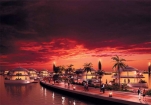Amphibious Hotel: Ashore and Afloat

This innovative project of the first semisubmerged hotel resort called Amphibious was designed for an Arabian commission. It appearance reminds of a big aquatic animal stretching out from the land into the sea and extends horizontally for 1km thanks to two long wide arms. The project is composed of a land section and sea section. All the structures are situated in a semi-circle around the tower with the panoramic restaurant.
On the land area is planned to arrange residential buildings, office buildings and a marina with a modern and flexible harbour. In the sea section there are four innovative semi submerged hotels with underwater halls that give fascinating views. The four hotels remind us of the soft lines of the super yachts anchored on land.
Large diagonal glass windows make the hotels unique, each with 75 luxury suites arranged around the perimeter of the building so each has a big terrace that overlooks the complex. The activities of the hotel take place in the underwater area that is surrounded by aquariums.
The hotels are situated around a central public welcome area that has an interactive museum on water life and water exhibition galleries, large perimeter aquariums and a glass tunnel, which leads to the underwater observatory in the centre of the whole marine park. Connected to the welcome area by the long arms are fitness areas, gardens and a special outdoor theatre with a moving stage that opens out on the sea.
To the smaller floating platforms will be anchored 80 floating suites called Jelly-fish with underwater views within the artificial reef. At the end of each platform are lighthouses. It is possible to move everywhere thanks to electrical vehicles that respect the eco-system philosophy.
The bridge that connects the land and sea section is limited with plants that give the idea of projecting the land flora into the sea. The main structure is in steel complete with all the necessary lighting systems and the floor is in teak.
Full content of this issue you can read here
The full version of the article can be read in our printed issue, also you can subscribe to the web-version of the magazine
 Materials provided by Giancarlo Zema Design Group
Materials provided by Giancarlo Zema Design Group


